I’m so excited to share these lilac bush landscaping ideas with you! If you’ve ever experienced the heavenly scent and gorgeous blooms of lilacs in spring, you know just how magical they can make a garden feel. Their lush blossoms and vibrant colors instantly create charm and romance in any outdoor space.
Lilac bushes are more than just beautiful plants. They bring a sense of nostalgia, often reminding us of childhood gardens or cozy spring afternoons. Their fragrant blooms can turn your yard into a dreamy escape while also attracting butterflies and hummingbirds for an extra touch of life and movement.
To make your lilac landscaping even more stunning, I’ve rounded up a few Amazon finds that pair perfectly with these timeless blooms.





Picture walking down a garden path lined with lilac bushes in full bloom, their sweet fragrance filling the air. A rustic bench sits beneath the blossoms, inviting you to pause and soak in the beauty. In the evening, soft garden lights glow around the lilacs, creating a romantic and enchanting scene right outside your door.
As you explore the ideas ahead, you’ll see just how versatile lilac bushes can be in transforming your garden into a breathtaking retreat.
Companion Plants for Lilacs
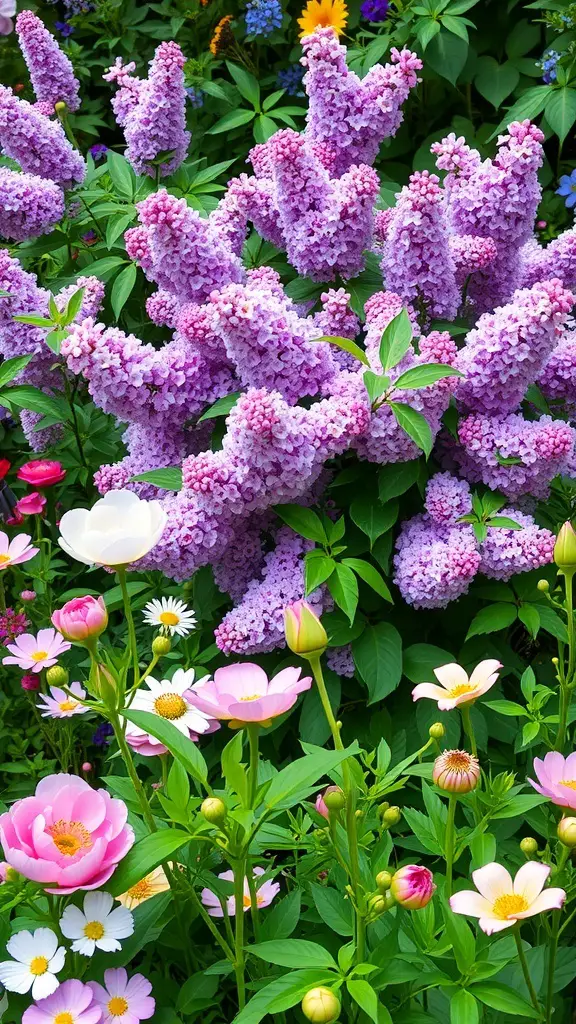
When planning a garden with lilac bushes, choosing the right companion plants can make a big difference. The image shows a stunning lilac bush surrounded by colorful blooms. This vibrant mix creates a lively scene, perfect for any garden.
Consider planting peonies alongside lilacs. Their round, lush flowers complement the lilac’s spiky blooms beautifully. Both plants thrive in similar conditions, making them a great match.
Another excellent choice is daisies. Their cheerful white petals add a fresh touch and contrast nicely with the lilac’s purple hues. Plus, they attract pollinators, which benefits the whole garden.
For a pop of color, try adding some annuals like marigolds or zinnias. These flowers bloom all summer long, keeping your garden lively even after the lilacs have finished flowering.
Lastly, consider some low-growing ground covers like creeping thyme. They can fill in gaps and provide a lovely green backdrop to the taller lilacs and other flowers.
Creating a Fragrant Lilac Border
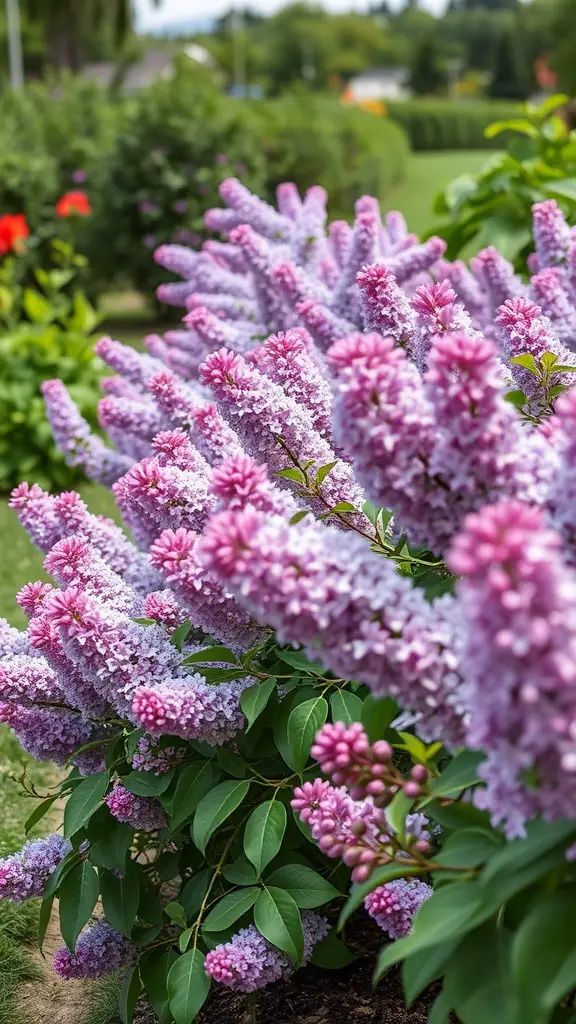
Imagine stepping into your garden and being greeted by the sweet scent of lilacs. These beautiful blooms can create a stunning border that not only looks great but also fills the air with fragrance.
When planting lilacs, choose a sunny spot with well-drained soil. They thrive in full sunlight, so make sure they get at least six hours of sun each day. Space them out to allow for their growth, as they can become quite bushy.
Consider mixing different varieties for a range of colors and bloom times. This way, you can enjoy lilacs throughout the spring. Regular pruning helps maintain their shape and encourages more blooms.
Adding mulch around the base can help retain moisture and suppress weeds. Plus, it gives a neat look to your garden. With a little care, your lilac border will become a favorite spot for both you and your visitors.
Seasonal Care Tips for Lilac Bushes
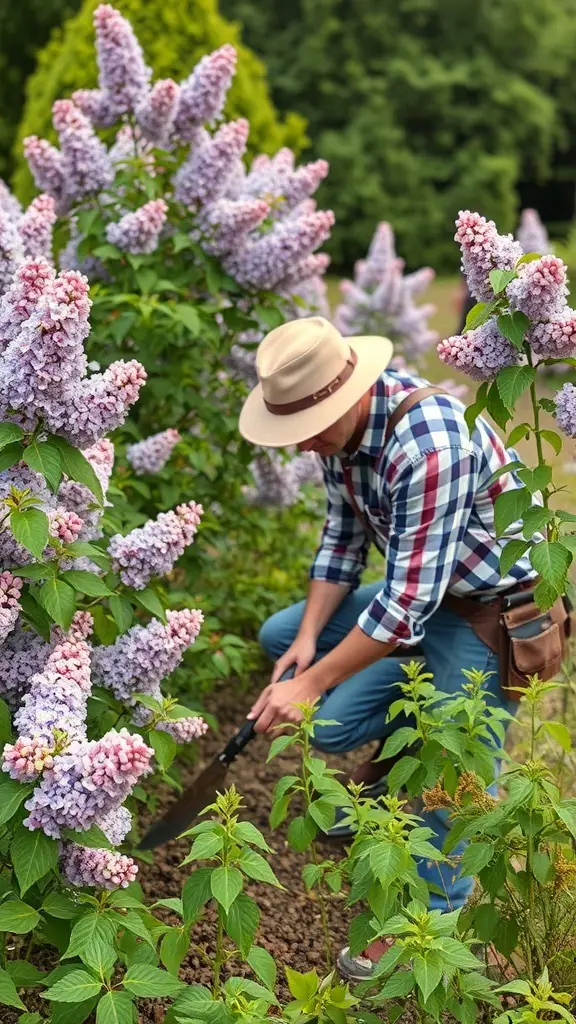
Taking care of lilac bushes can be a rewarding experience. These beautiful plants bring vibrant colors and delightful scents to your garden. In the image, a person is tending to lilac bushes, showcasing the hands-on approach needed for their care.
Spring is the perfect time to prune your lilacs. This helps promote healthy growth and encourages more blooms. Make sure to cut back any dead or weak branches. You want to shape the bush while keeping its natural form.
Watering is essential, especially during dry spells. Lilacs prefer well-drained soil, so ensure they’re not sitting in water. A good rule of thumb is to water deeply once a week.
Fertilizing your lilacs can boost their growth. Use a balanced fertilizer in early spring. This gives them the nutrients they need to thrive throughout the growing season.
As summer approaches, keep an eye out for pests. Aphids and spider mites can be common nuisances. If you spot any, treat them promptly to keep your lilacs healthy.
In the fall, it’s time to prepare your lilacs for winter. Mulching around the base helps protect the roots from freezing temperatures. This simple step can make a big difference in their survival.
Lilac Bushes: Attracting Pollinators
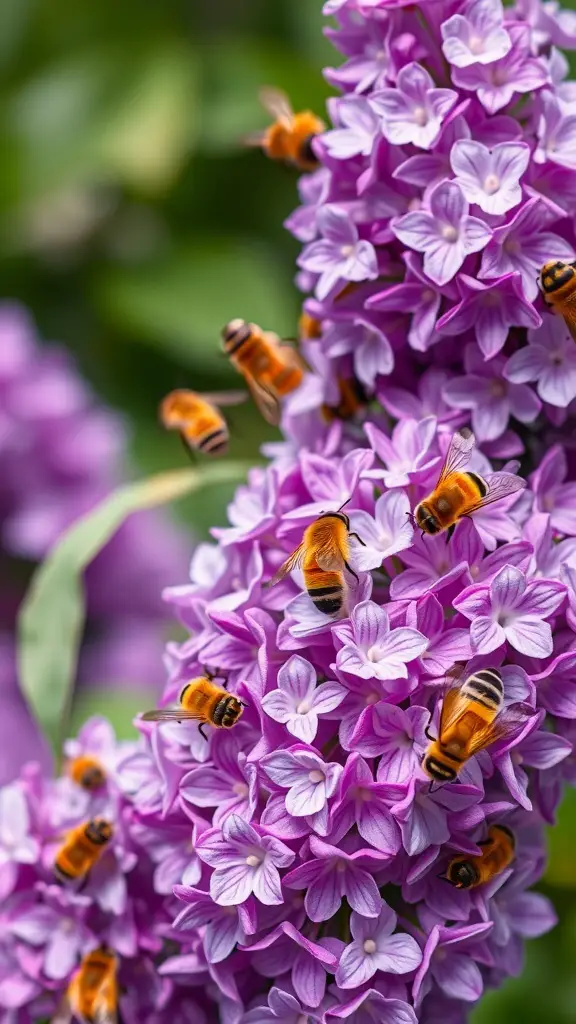
Lilac bushes are not just beautiful; they play a big role in attracting pollinators like bees. The vibrant purple flowers are a feast for the eyes and a magnet for these important creatures.
When lilacs bloom, they fill the air with a sweet fragrance. This scent draws in bees, which are essential for pollination. As bees move from flower to flower, they help plants reproduce, ensuring a healthy garden.
Having lilac bushes in your yard can create a lively atmosphere. Watching bees buzzing around the flowers is a delightful sight. Plus, it supports local ecosystems by providing food for pollinators.
To make the most of your lilac bushes, consider planting them in sunny spots. They thrive in well-drained soil and will reward you with stunning blooms. This not only enhances your landscape but also boosts the presence of pollinators in your garden.
Designing a Lilac Hedge for Privacy
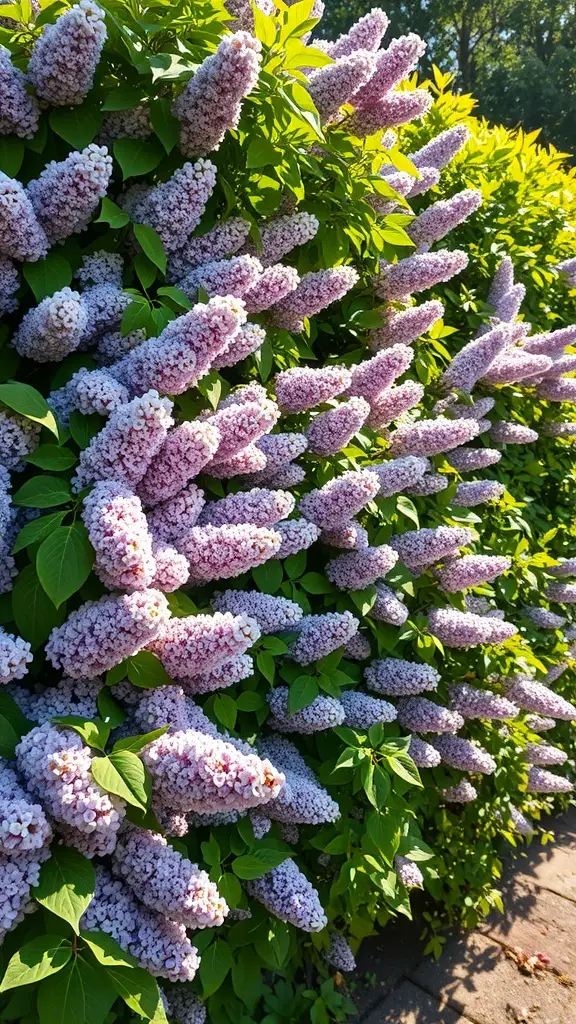
Creating a lilac hedge can be a fantastic way to add both beauty and privacy to your yard. The image shows a lush lilac bush, bursting with clusters of soft purple flowers. These blooms not only look lovely but also fill the air with a delightful fragrance.
When planning your lilac hedge, think about the space you have. Lilacs can grow quite large, so ensure you give them enough room to flourish. A well-placed hedge can act as a natural barrier, keeping your outdoor space cozy and secluded.
Consider planting a mix of different lilac varieties for a more dynamic look. This can create a stunning visual effect and extend the blooming season. The vibrant colors and textures will enhance your landscape while providing the privacy you desire.
Don’t forget about maintenance! Regular pruning will keep your lilacs healthy and encourage more blooms. With a little care, your lilac hedge can thrive, offering both beauty and a peaceful retreat in your garden.
Designing a Lilac-Centric Landscape

Creating a lilac-centric landscape can bring a fresh and vibrant feel to your outdoor space. Imagine walking along a winding path framed by lush lilac bushes, their fragrant blooms adding color and charm. The soft purple hues of the lilacs can beautifully contrast with the greenery around them.
Consider using stepping stones to guide visitors through your garden. This not only adds a practical element but also enhances the visual appeal. The path can meander through clusters of lilacs, making each turn a delightful surprise.
Incorporating other plants can complement the lilacs. Think about adding some tropical foliage or bright flowers to create a lively atmosphere. This mix can help your garden feel more dynamic and inviting.
Don’t forget about the layout! A well-planned arrangement of lilacs can create focal points throughout your yard. Grouping them in clusters can make a bold statement, while spacing them out can allow for a more relaxed feel.
Lastly, consider the seasons. Lilacs bloom in spring, so think about what other plants will provide interest during other times of the year. This way, your garden will always have something to offer.
Choosing the Right Lilac Variety for Your Garden
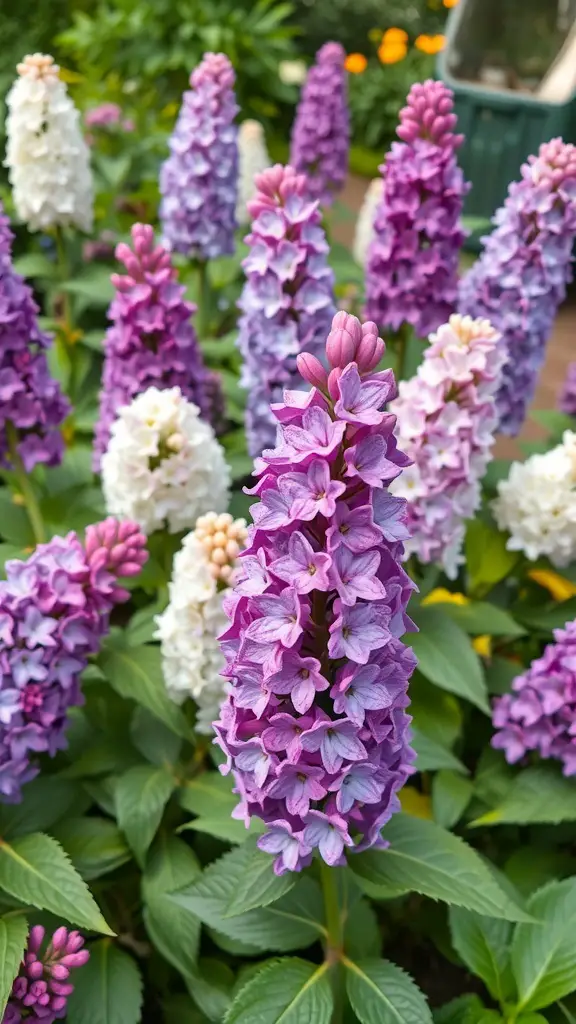
When selecting lilacs for your garden, it’s essential to know the different varieties available. Each type brings its unique charm and color. The image showcases a beautiful array of lilac blooms in shades of purple and white, illustrating the vibrant options you can choose from.
Some popular varieties include the common lilac, which is known for its classic fragrance, and the Japanese tree lilac, which offers stunning white flowers. Think about the color palette you want to create in your garden. Do you prefer deep purples or soft pastels? The lilacs in the image highlight how these colors can complement each other beautifully.
Consider the size of your garden space too. Some lilacs grow tall and wide, while others stay more compact. The variety you choose will impact how they fit into your overall landscape design. Take a moment to visualize how these lovely blooms will enhance your garden.
Lastly, think about the growing conditions. Some lilacs thrive in full sun, while others can tolerate partial shade. Make sure to match the lilac variety to your garden’s environment for the best results. With the right choice, your garden can be a stunning display of lilac beauty!
Incorporating Lilacs into Small Spaces
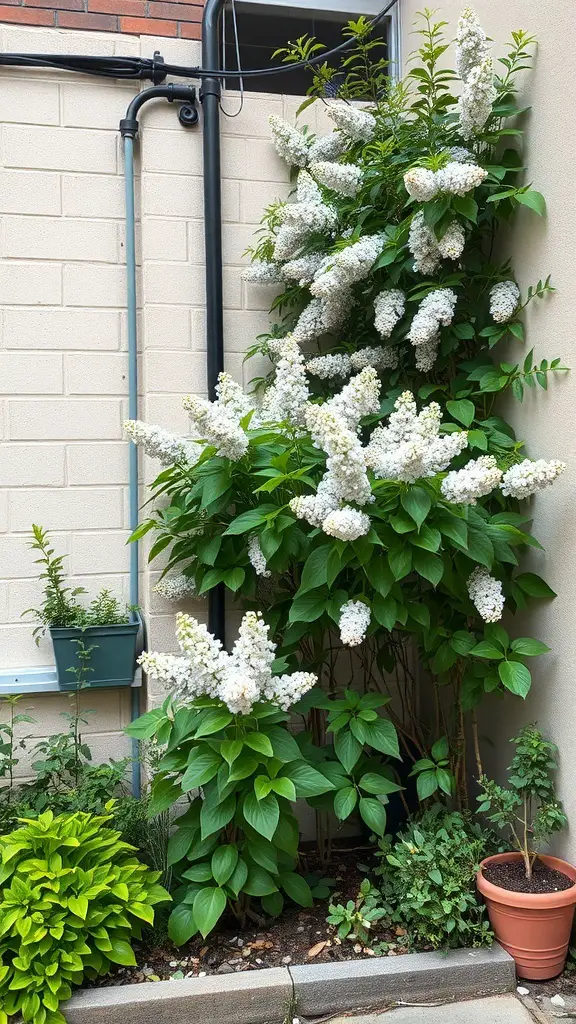
Lilacs are a fantastic choice for small gardens. Their lovely blooms can bring life to even the tiniest corners. In the image, you can see a beautiful display of lilac bushes against a wall. The white flowers create a striking contrast with the green leaves, making the space feel fresh and inviting.
When working with limited space, consider planting lilacs in vertical arrangements. This allows you to maximize your area while still enjoying their beauty. The lilacs in the image are positioned near a wall, which is a smart way to use vertical space.
Mixing lilacs with other plants can also enhance the look. The surrounding greenery in the image adds depth and texture. You can choose low-growing plants to complement the height of the lilacs, creating a layered effect.
Don’t forget about pots! Using containers can help you add lilacs to patios or balconies. The potted lilac in the image shows how versatile these plants can be. Just ensure they get enough sunlight and water to thrive.
Lilac Bush Maintenance Throughout the Year
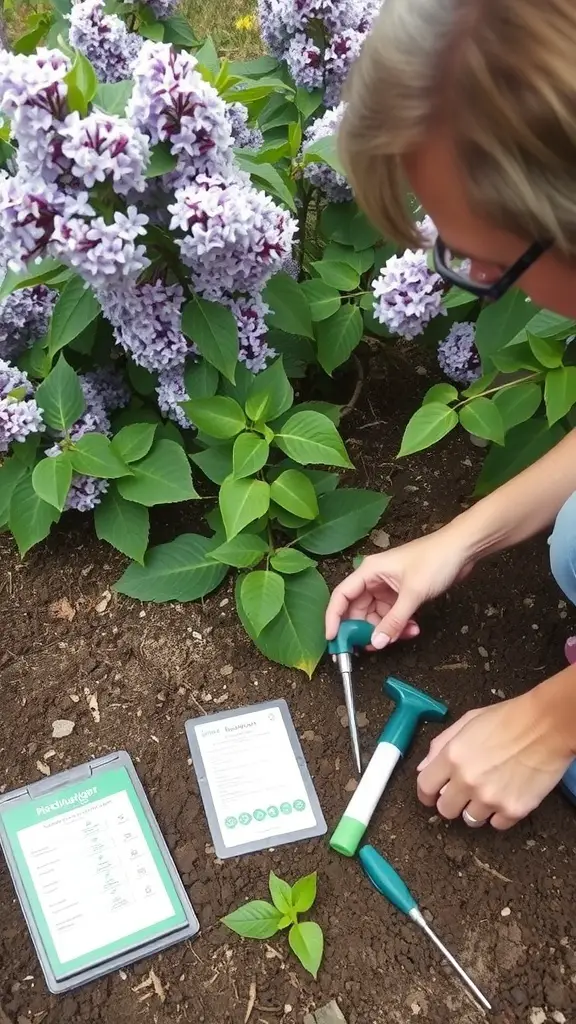
Lilac bushes are a beautiful addition to any garden, known for their stunning purple blooms and delightful fragrance. To keep them thriving, regular maintenance is key.
In spring, after the last frost, it’s time to prune. This helps promote healthy growth and encourages more flowers. Make sure to remove any dead or damaged branches.
During the summer, watering is essential, especially in dry spells. Lilacs prefer well-drained soil, so avoid overwatering. A layer of mulch can help retain moisture and suppress weeds.
As fall approaches, consider fertilizing your lilacs. A balanced fertilizer can give them the nutrients they need to prepare for winter. Also, clean up fallen leaves to prevent pests and diseases.
Winter care is minimal, but protecting the base of the plant with mulch can help insulate the roots from extreme cold. With these simple steps, your lilac bushes will flourish year after year.
Using Lilacs for Cut Flower Arrangements
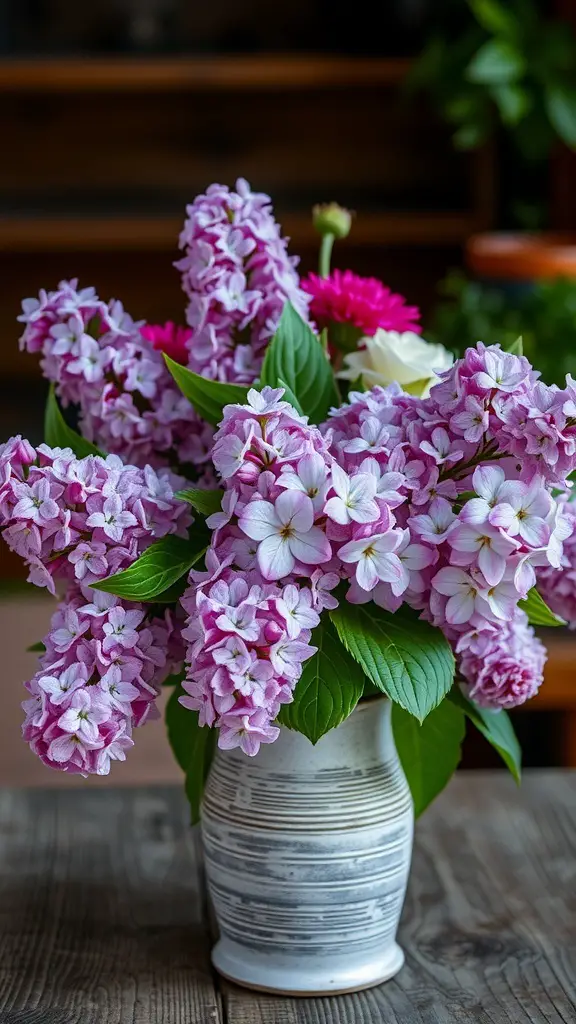
Lilacs are a fantastic choice for cut flower arrangements. Their soft purple hues and delightful fragrance can brighten up any space. The image shows a beautiful bouquet of lilacs, showcasing their lush blooms and vibrant green leaves. This arrangement captures the essence of spring and brings a touch of nature indoors.
When using lilacs in arrangements, consider mixing them with other flowers for variety. Pairing them with contrasting colors can create a stunning visual effect. For example, adding white daisies or yellow roses can enhance the lilacs’ beauty.
To keep lilacs fresh, trim the stems at an angle and place them in water immediately. Change the water every few days to prolong their life. With their charming appearance and sweet scent, lilacs can make any arrangement feel special.
The Importance of Soil Quality for Lilacs
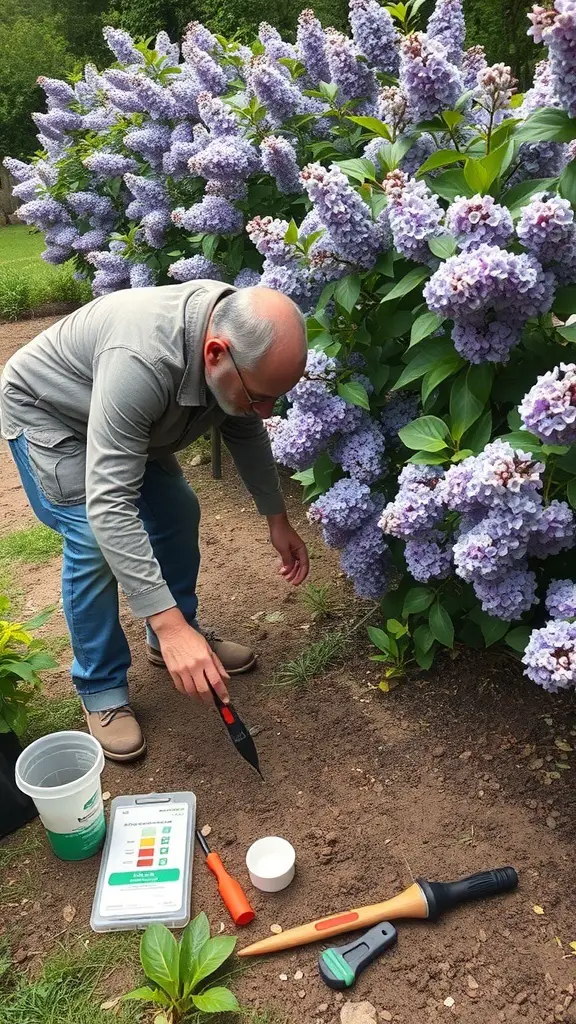
Soil quality plays a big role in how well lilacs grow. In the image, a person is checking the soil near beautiful lilac bushes. This shows that taking care of the soil is key to having healthy plants.
Good soil provides the right nutrients and drainage for lilacs. It’s important to test the soil to see what it needs. The tools in the picture, like the soil tester and trowel, are perfect for this job. They help ensure the soil is just right for these lovely flowers.
When the soil is healthy, lilacs can thrive and produce stunning blooms. This not only enhances the garden’s look but also attracts pollinators. So, investing time in soil quality can lead to a more vibrant and colorful landscape.
Lilacs in Historical and Cultural Landscapes
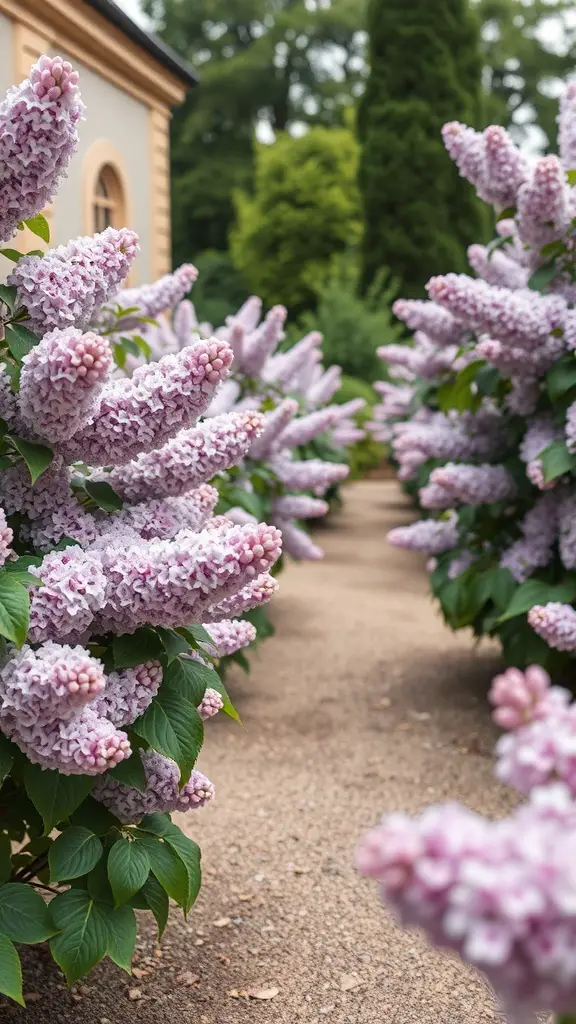
Lilacs have a rich history in gardens and landscapes around the world. These beautiful flowers are often associated with spring, bringing a burst of color and fragrance that many people cherish. Their presence in historical gardens adds a touch of nostalgia and beauty.
In various cultures, lilacs symbolize love and renewal. They have been used in traditional ceremonies and celebrations, making them a popular choice for landscaping in public parks and private gardens alike. The soft lilac hues can create a calming atmosphere, perfect for relaxation or reflection.
Many famous gardens feature lilacs, showcasing their beauty during blooming seasons. Visitors often stroll through paths lined with these fragrant blooms, enjoying the sights and scents. Incorporating lilacs into your own landscape can evoke a sense of history and connection to nature, making them a timeless choice for any garden.
Color Combinations with Lilac Flowers
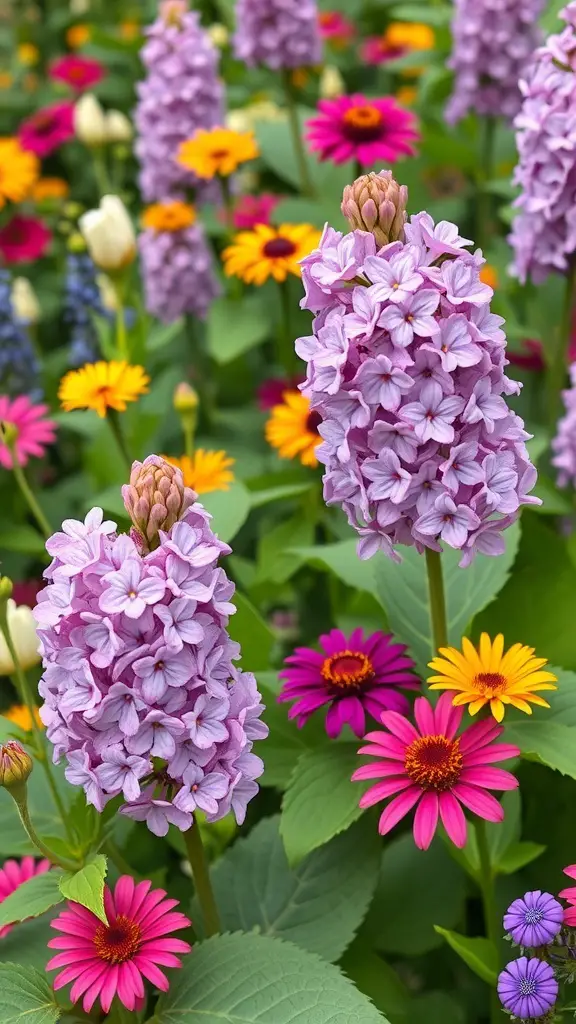
Lilac flowers bring a soft, charming touch to any garden. Their delicate purple hues can create stunning combinations with other colors. In the image, you can see lilac flowers standing tall among vibrant blooms.
Pairing lilacs with bright yellows and pinks, like the zinnias in the foreground, creates a lively contrast. This mix not only highlights the lilac’s beauty but also adds a cheerful vibe to the landscape.
Consider adding white or blue flowers to complement the lilac. These colors can enhance the serene feel of the garden. The combination of lilac with cool tones can create a calming space, perfect for relaxation.
Using different shades of purple alongside lilacs can also be effective. Darker purples can add depth, while lighter shades keep the look airy. This layering of colors can make your garden visually interesting.
Don’t forget about foliage! Green leaves can act as a neutral backdrop, allowing the lilac and other flowers to shine. Mixing textures with various leaf shapes can also add dimension to your garden.
Lilac Bushes in Different Garden Styles
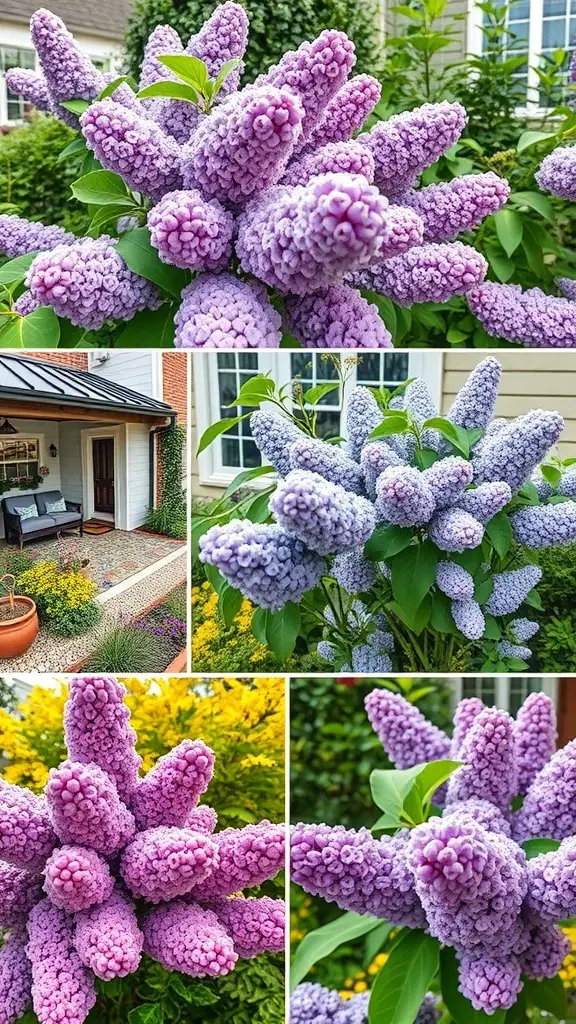
Lilac bushes bring a splash of color and fragrance to any garden. Their beautiful purple blooms can enhance various garden styles, from traditional to modern.
In a cottage garden, lilacs can create a charming, whimsical feel. Pair them with daisies and other wildflowers for a relaxed look. For a more structured garden, consider planting lilacs in neat rows. This works well in formal gardens, adding elegance and symmetry.
In contemporary landscapes, lilacs can be used as focal points. Their vibrant colors can contrast beautifully with sleek, minimalist designs. You might also use them to soften hardscapes, like patios or walkways.
Mixing lilacs with other shrubs can create a lush backdrop. They thrive in sunny spots, so place them where they can soak up the sun. With proper care, these bushes can bloom year after year, making them a delightful addition to any garden.
Maximizing Bloom Time for Lilac Bushes
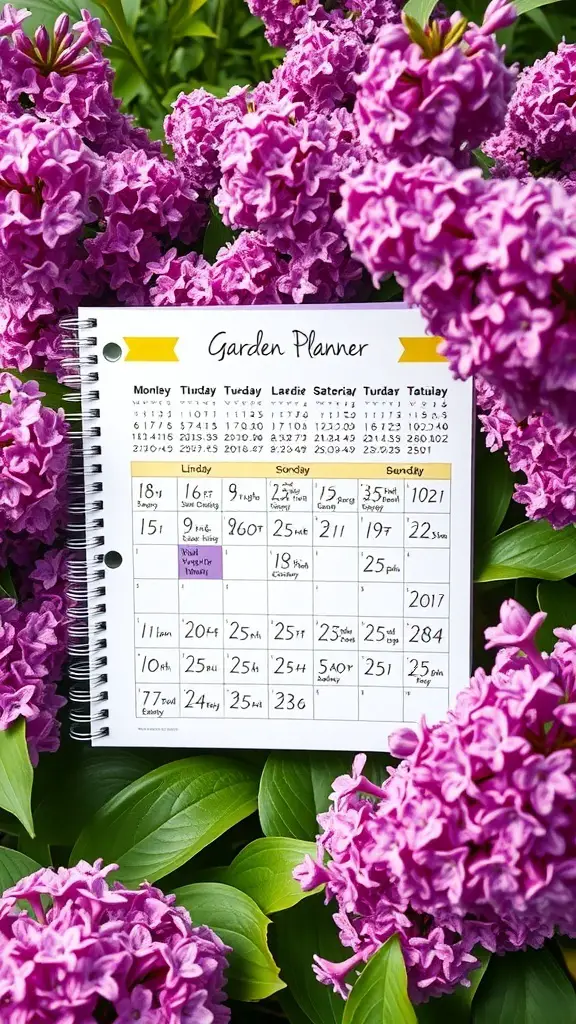
In the image, vibrant lilac blooms surround a garden planner, highlighting the beauty of lilac bushes. These flowers are not just pretty; they can fill your garden with delightful scents and colors.
To maximize bloom time, timing is key. Plant lilacs in early spring or fall for the best results. They thrive in well-drained soil and full sunlight, so choose the right spot in your yard.
Regular pruning can also help. Trim back spent blooms after flowering to encourage new growth. This simple step can lead to more flowers next season.
Watering is essential, especially during dry spells. Keep the soil moist but not soggy, and your lilacs will reward you with beautiful blooms.
Using a garden planner, like the one in the image, can help you track when to plant, prune, and water. It’s a handy tool for keeping your lilac bushes healthy and blooming beautifully.



